pRopE Rt y
VICTORIA
Climate resilient assets
Building a sustainable future.

LOBBY LOWDOWNSPRING STREET SWEEPINDUSTRY INSIGHTSMEDIA HEADLINES APRIL/MAY 2013 Registered by Australia Post No. PP38667/00182
GREEN ISSUE
A rugby spectacular 12 years in the making!

Eagerly awaited since 2001, the Lions tour series will land in Australia this June.
Don’t miss out on being part of the action!
Join our rugby fanatic MC, Adam Freier as he leads Lions Legend, Rory Underwood and Wondrous Wallaby, Stirling Mortlock on a review of the matches and what’s in store for the final games.


With highly respected, knowledgeable and entertaining speakers – this is an event not to be missed!


are coming Business Lunch WeD 26th June 2013 Guest speakers: RoRy UndeRwood
MoRtlock AdAM FReieR 12.30pm for 1pm-2.30pm at ZINC federatIoN Square | memberS: $145.00 | NoN memberS: $215.00
The LIONS
StiRling
Cancellations MUST be notified in writing 5 (five) working days prior to this event. After this time no registration fees will be refunded, but replacements will be accepted. Bookings, cancellation and queries can be emailed to: vicevents@propertyoz.com.au Proudly partnered by
Inside this Issue
Property’s Voice Time for a Victorian Planning Authority.
Jennifer Cunich, Executive Director Property Council of Australia 5

The High-rise Revolution
How China is building the tallest, cheapest, most resilient and sustainable towers in days.


Juliet Jiang, Broad Group 11
Climate Resilient Assets

Managing the risks of climate change.
Mark Allan, Billard Leece Partnership Architects
Gerard Healey, Arup
Insurance Industry Initiatives
13
Partners of the Month
April May
Property Council of Australia (Victoria Division)
Level 7, 136 Exhibition Street
Melbourne Victoria 3000
Phone: 03 9650 8300
Fax: 03 9650 8693
Email: vic@propertyoz.com.au
Website: www.propertyoz.com.au
EDITOR
Danni Addison
Phone: 03 9650 8300
Email: daddison@propertyoz.com.au
ASSISTANT EDITOR
Hyatt Nidam
Email: hnidam@propertyoz.com.au
Property Victoria is published bi-monthly. The Publisher reserves the right to alter or omit any article or advertisement submitted and requires indemnity from the advertisers and contributors against damages or liabilities that may arise from material published.
The need for a resilient built environment has never been so prominent.
Karl Sullivan, Insurance Council of Australia 17

Perfect Time for Building Retrofits
The commercial sector needs to focus on the refubishment of existing buildings.
Tony Arnel, Norman Disney & Young
twitter.com/propertyozvic
WARRANTY AND INDEMNITY
Advertisers and/or advertising agencies upon and by lodging material with the Publisher for publication or authorising or approving at the publication of any material INDEMNIFY the Published, servants and its agents against all liability claims or proceedings whatsoever arising from the publication without limiting the generality of the forgoing to defamation, slander of title, breach of copyright, infringement of trademarks or names of publication titles, unfair competition or trade practices, royalties or violation of rights or privacy AND WARRANT that the material complies with all relevant laws and regulations that publication will not give rise to any rights against or liabilities in the Published, servants or agents and in particular nothing therein is capable of being misleading or deceptive or otherwise in breach Part IV of the Trade Practices Act 1974.
www.propertyoz.com.au
form or by any means electronic, mechanical, photocopying, recording or otherwise without permission of the Publisher.
DESIGN
Blick Creative
1st Floor/382 Queens Pde Clifton Hill VIC 3068
www.blickcreative.com.au
DISPLAY AND CLASSIFIED ADVERTISING
Danni Addison
Property Council of Australia (Victoria Division)
Level 7, 136 Exhibition Street
Melbourne VIC 3000
Phone: 03 9650 8300
Fax: 03 9650 8693
Email: daddison@propertyoz.com.au
GREEN ISSUE: PROPERTY VICTORIA APRIL/MAY 2013 Inside this Issue Lobby Lowdown 6 Spring Street Sweep 7 Industry Insights 8 Media Headlines 9 Advocacy Update 19 Mentor Programme 2013 26 Property Podium 27 Spotlight on Tasmania 28 Events 29 Events Calendar 42
COPYRIGHT No part of this publication may be reproduced, stored in a retrieval system, or transmitted in any
3
21
MAJOR PARTNERS
SuSTAINABIlIT y PARTNER
DESIGN PARTNER

GREEN ISSUE: PROPERTY VICTORIA APRIL/MAY 2013 4
property’s Voice
Time for a Metropolitan Planning Authority
Goodplanning coupled with the right execution delivers successful outcomes. With Victoria’s population forecast to reach 8.7 million in the next 40 years, we need to ensure this growth results in a more vibrant and thriving state for all of our residents. The Metropolitan Planning Strategy is our chance to lay a solid foundation for the jobs, housing, infrastructure and services we will need to accommodate population growth now and into the future.
Victoria has long suffered from an overly lengthy, inconsistent, expensive and highly politicised planning system. Application delays, unpredictable decision making, legal maneuvering, convoluted policies and poor strategy application are some of the factors which constantly prevent the delivery of what our communities need most; reliable and affordable decision making to manage the challenges of growth. The cost of poor management is too detrimental for this state to ignore. Without a rejuvenated and innovative approach to how the planning system is governed, we cannot expect much to change.
Planning Minister Guy, to his credit, has recognised these challenges. His decision to establish a planning authority responsible for the implementation of the Metropolitan Planning Strategy will make a big difference in determining whether the strategy succeeds, or simply follows in the footsteps of its policy predecessors.
same mistake again. The Government’s early acknowledgement of this has shone through in its commitment to a full consultation process. A sense of ownership from community, local government and industry will be instrumental in the implementation of the Metropolitan Planning Strategy. A ‘bottom up’ strategy can prevail.
Jennifer Cunich Executive Director, Victoria Division
If Victoria is to manage its future growth challenges, it cannot afford to make this


With ownership, the strategy will also need to have a driving force. The Property Council has long advocated for the establishment of a planning authority to ensure successful policy implementation. A planning authority is the only framework that will effectively coordinate state government activity, while also facilitating the enormous task of overseeing the implementation of the Metropolitan Planning Strategy at the local level. Only by empowering a new body outside of the daily political pulpit can Victorians have faith that local government will deliver in their role as long term community planning authorities. Setting it up with the right people, the right structure and the right direction will give it the best chance at success. Furthermore, it will need sound leadership, authority,
funding and legislative standing to ensure it is empowered to act decisively. Above all, it must be accountable to the community for delivering tangible outcomes.
The need for the Metropolitan Planning Strategy is clear; Victoria is growing in numbers and we must keep pace with this growth in order to preserve livability. Implementation will be critical and a planning authority established to guide the process will give the strategy the best chance of success.
The new Metropolitan Planning Authority has a significant role to play in this this state. We hope it will be equipped with the right tools to do its job properly.
Jennifer Cunich Executive Director, Victoria Division Property Council of Australia

GREEN ISSUE: PROPERTY VICTORIA APRIL/MAY 2013 5
One of the greatest criticisms of Melbourne2030 was that those responsible for its implementation had little faith in the policy. Furthermore, their disagreement with its ‘top down’ objectives meant that only a portion of its vision was implemented.
property’s Voice
Lobby Lowdown
Let’s talk about the future
TheProperty Council has made its submission to the Metropolitan Planning Strategy Ministerial Advisory Committee’s Discussion Paper, Melbourne, Let’s Talk About the Future.
The Property Council supports the need for a new metropolitan strategy that facilitates the growth and development of Melbourne over the next 30 to 40 years. The development of the Metropolitan Planning Strategy (MPS) is an opportunity to ensure Melbourne’s distinctive features are preserved and enhanced as Victoria continues to evolve in the future.
The strategy itself must guide future policy and decision-making by dealing with the key issues facing Melbourne’s growth. This includes - but is not limited to – managing population growth, the planning and delivery of vital infrastructure including transport, affordable housing, keeping downward pressure on construction and planning costs, competitive office space and high quality educations services. The metropolitan strategy should also facilitate urban renewal and regeneration to make more efficient use of underutilised land.
With Melbourne’s population forecast to increase considerably by 2050, we need to ensure we can accommodate this growth. The MPS is our chance to lay a
solid foundation for the jobs, housing, infrastructure and services we will need in the future.
In our submission, the Property Council has advocated that the MPS should guide policy and decision-making, include the facilitation of urban renewal and the planning and delivery of vital infrastructure. Areas needing urgent attention such as transport infrastructure, affordable housing, competitive office space and high quality education services have been identified as priorities.
The Property Council supports the establishment of a new Metropolitan Planning Authority. It should have a coordinating role and be endowed with sufficient powers to provide implementation directions to other areas of state and local government.
The Property Council has been advocating for a planning authority for over a decade.
We believe it will provide an effective governance framework to coordinate state government activity, while also facilitating the implementation of the strategy at the local level.
Planning Minister Guy has agreed to establish an authority responsible for the implementation of the MPS. Its approach will be vital in ensuring that local governments deliver in their role as community planners.
The MPS will no doubt face challenges. The Property Council has outlined demographic and economic changes within the submission as well housing stress, underutilised land for urban renewal, a flagging transport system and increasing infrastructure needs as some of the key problems the strategy will need to address.
The Property Council’s vision for the future of Victoria is a productive, sustainable and livable state that maximizes all forms of community capital. In our submission to the discussion paper for the Metropolitan Planning Strategy for Melbourne, we are working hard to reach this common goal.

GREEN ISSUE: PROPERTY VICTORIA APRIL/MAY 2013 6 Lobby Lowdown
Spring Street Sweep
Drawing the line around infrastructure provision

TheProperty Council has been actively engaged with the Standard Development Contributions Advisory Committee and the Growth Areas Authority (GAA) on its development of a Works in Kind (WIK) framework for the payment of the Growth Areas Infrastructure Charge.
These two processes have highlighted the interconnectivity of various developer contribution frameworks and the inability of Victoria’s system to adequately define what is, and what is not considered to be state infrastructure.
The definition of what constitutes state infrastructure has never been adequately determined by the Victorian Government or its departments and agencies. Developing and agreeing to such a definition will be vital to the success of any WIK system and also to the ongoing operation of associated processes, such as the collection of development contributions.
The Property Council has consistently advocated for clear guidance, developed in partnership with local government and the development industry, defining state infrastructure.
For Melbourne’s designated growth corridors in particular, we have suggested a list of items which should clearly be identified as state infrastructure including:
• Road construction such as intersections for roads that are designated arterial
roads, or are envisaged to be designated arterial roads when developed to their ultimate extent;
• Grade separation to rail lines;
• Intersection works associated with road/ rail interconnectivity;
• Works associated with traffic connection to freeways and tollways including bridges, on and off ramps and intersections; and
• Bridge crossing of designated waterways.
Melbourne City Council open space contributions
The Property Council has engaged closely with the Melbourne City Council throughout development of its Open Space Strategy and associated Open Space Contributions Framework.
We have several philosophical disagreements with the approach that has been taken to the development of its Open Space Strategy. Our primary concern is that the strategy proposed represents a 20th century solution to a 21st century challenge (of providing high-quality open space in a city with a growing residential and work population). When dealing with this issue, the City of Melbourne is only thinking about the outside of buildings, not the inside. The open space strategy is only planning for open space at the street level, rather than above it, below it and on water.
There are also worries that the City of Melbourne is attempting to impose retrospective contributions to make up for an acknowledged deficiency in open space provision across the municipality.
The Property Council has met with the Lord Mayor and key councillors as well
as council officers. We will continue to campaign for a fairer framework for open space contributions that will see the most value achieved for our city.
Differential council rates
The Property Council of Australia has lodged a submission to the Victorian Government on its Review of Differential Rates Guidelines.
In our submission, we expressed apprehension towards the current model of differential rates within the Victorian local government system. Key recommendations included that the Victorian Government:
• Work with local governments to develop and implement a simpler and flatter differential rate structure to ensure that greater equity is provided to the business community;
• Caution local government against misusing differential rating policy and reject unfair rating proposals where appropriate;
• Actively discourage the implementation of ‘industry policy’ measures through differential rates which undermine State and Federal Government economic strategy;
• Introduce a 25 per cent discount differential rate (or rebate) for selfsufficient ratepayers who are currently paying rates for council services which they are already receiving at their own private expense; and
• Conduct a review of retirement village asset rating methodology to ensure an equitable assessment procedure is utilised to determine asset values and capacity to pay.
GREEN ISSUE: PROPERTY VICTORIA APRIL/MAY 2013 7 Spring Street Sweep
ADDING VALUE TO CHALLENGING PROJECTS + Creative Structural and Civil Engineering Design Solutions + Innovation and Experience + Quality, Cost and Buildability Focus - Optimal Project Outcomes + BIM Modelling – Efficient Documentation Delivery T +61 3 8327 8600 | www.winward.com.au Melbourne + Brisbane + Perth + London +
Industry Insights
New Members
Members Update
Places Vic appoints interim CEO
Graeme Parton retires from Charter Keck Cramer

After 40 years in the property industry, Graeme Parton has retired from his role as Director of Charter Keck Cramer. Mr Parton cofounded and directed Pinnacle Property Group for over 20 years before its merger with Charter Keck Cramer five years ago.
Throughout his impressive career, Mr Parton has established himself as a highly skilled development and project manager with expertise in property investment, development, construction, due diligence investigation and economics. He is an expert in strategic planning, development and investment projects and will continue to be involved in various boards, committees and advisory roles.
Peter Seamer, CEO of the Growth Areas Authority, has been appointed to acting CEO of Places Victoria. Mr Seamer will be the chief executive for six months while the organisation undergoes broad internal restructuring. Mr Seamer has previously worked in engineering, planning and management and has a Master of Urban Planning and a Master of Engineering Science in Transport Planning, both from Melbourne University.
New VicTrack CEO
On February 6, Campbell Rose began his three year term as chief executive of VicTrack. Mr Rose has a proven track record in transport co-ordination, property development, major infrastructure planning, improving business performance and community engagement. He is the former CEO of the Western Bulldogs, Stralliance Developments, the Melbourne Major Events Company and was responsible for running the successful 2006 Melbourne Commonwealth Games bid.
New project director for Thinc
Cris Johansen has been appointed as Project Director of Thinc. Mr Johansen has 20 years’ prior experience in the construction market, working for
some of Australia’s leading property and construction companies including Abigroup, Australand and Lend Lease. He is a trained quantity surveyor and has a Masters of Business Adminstration from the Australian Graduate School of Management.
CBRE expanding residential valuations
CBRE’s Residential Valuations sector has appointed Chris Noseda to expand the business within the Greater Geelong, Bellarine Peninsula and Surf Coast region. Mr Noseda is a real estate professional with 10 years’ property experience in Victoria who has previously undertaken residential valuations for a range of major lenders.
Moray & Agnew appoint new planning and development head
Moray & Agnew Lawyers has appointed Scott Stewart, previously a leader of planning and environment at Rigby Cooke, to run its Planning and Development practice in Melbourne. Mr Stewart has played a key role in many of Victoria’s largest development projects and is one of the State’s most widely respected planning and environmental lawyers.
GREEN ISSUE: PROPERTY VICTORIA APRIL/MAY 2013 8 Industry Insights
VICTORIA DIVISION MEMBER T y PE REPRESENTATIVE ACDEV Core Tim Schaefer Country Club Villages Core Andrew Preston Bonacci Group Associate Dermot Murray Cundall Johnston & Partners Associate Andrew Thompson Evans & Peck Associate Glenn Maguire Sellick Consultants Associate Delvin O'Meara Studio 103 Pty Ltd Associate Emma Hynes TASMANIA DIVISION MEMBER T y PE REPRESENTATIVE Groom Kennedy Associate James Groom
Graeme Parton Charter Keck Cramer
Headlines









Letter to the editor

Mr Skyscraper
The article ‘Planning expert blasts legacy of ‘Mr Skyscraper’’ (19/03) sends a conflicting message to one published last month, ‘State at a standstill as major projects wind up’ (05/02).

The latter drew attention to the lack of construction going ahead in Victoria. It highlighted job losses within the building industry as a major issue. The former, brands Planning Minister Matthew Guy as doing the state a disservice (‘Mr Skyscraper’) for approving the construction of a high-rise tower in Southbank.
By saying yes to Australia 108, Minister Guy has created hundreds of jobs. Members of the construction industry can breathe a little easier knowing more work had been generated for them. The project will also be responsible for a $600 million investment into the Victorian economy. These are the decisions that prevent the state coming to a standstill.
It does us no favours to point out a problem only to ignore it. A key issue was identified and a solution found.






If Australia 108 were to be built in a quiet neighbourhood street, a negative reaction would perhaps be warranted. But if we cannot build tall in the city, where can we? There is no better way to drive employment,

investment and accommodate population growth in this State than to develop Melbourne’s CBD.
Jennifer Cunich, Victorian Executive Director, Property Council of Australia

Ballooning land tax bills won’t be capped
TheAge reported on 20 March 2013 that the Victorian Government will not reduce land tax despite bill increases of 1400 per cent per annum.
Jennifer Cunich, Victorian Executive Director of the Property Council, commented that a fairer long-term tax strategy should be a priority for the State Government and advocated for putting a cap on the land tax rate.
Despite industry experts warning that soaring land tax bills will attack and erode the capital values of city properties, Treasurer Michael O’Brien has said, “No work is being undertaken on capping annual land tax increases.”
In the week prior, The Age’s BusinessDay printed findings of a survey conducted by property firm Kliger Wood. They revealed that rising land values have seen land tax bills increase by 80 per cent to 250 per cent for some retail properties in Southbank and the CBD.
The Property Council will continue its campaign for a long term tax strategy that includes a fairer and flatter land tax structure.
It’s the AAA rating or infrastructure

TheAge economics editor, Tim Colebatch has argued the State Government is holding onto the AAA rating at the expense of Victoria’s infrastructure needs.
Colebatch listed over 10 of Victoria’s planned infrastructure projects as priorities. Citing the Property Council’s report Securing Victoria’s Future – A Program to Plan, Fund and Deliver Infrastructure, he wrote that building the missing section of the outer ring road between Greensborough and the Eastern Freeway would cost $6 billion alone.
Colebatch wrote that one of the most important issues facing the State Government is how to pay for the infrastructure we need. He went on to suggest that Victoria should stop holding onto the AAA rating which helps us to pay a slightly lower interest rate and instead use that money for infrastructure. The Property Council’s Infrastructure Committee is looking at these issues in greater detail.
GREEN ISSUE: PROPERTY VICTORIA APRIL/MAY 2013 9 exceptional chartered building consultancy & environmental services for Australasian property investors, owners, tenants, financiers and asset managers. • Technical Due Diligence - Acquisition / Disposal • Make Good / Dilapidations Reporting • End of Lease Make Good / Dilapidations Negotiations • Schedules of Condition • Tax Depreciation • Project & Contract Administration • CAPEX & Maintenance Forecasting • Expert Witness Reporting / Defect Reports • Asbestos & Hazardous Materials Registers / Assessments • Environmental Investigations (PSI / DSI) • NABERS & BEEC www.sgaproperty.com Sydney Melbourne Brisbane Perth Auckland Hong Kong Contact - Bruce Corrin P: +61 3 9670 6737 E: melb@sgaproperty.com C M Y CM MY CY CMY K SGA 172 AdvertA.ai 1 3/08/12 1:59 PM Media Headlines Media

GREEN ISSUE: PROPERTY VICTORIA APRIL/MAY 2013 10 The High-rise Revolution
The High-rise Revolution
TheBroad group is one of the few Chinese enterprises to be widely recognised for its sustainable practises and commitment to countering climate change.
In the last few years it established Broad Sustainability Building (BSB), which has since become the world’s most efficient and environmentally friendly construction company. Tackling issues related to natural disasters, pollution, conservation of natural resources, housing affordability, urbanisation and time sensitivity, the BSB is concerned with many of the same problems we face here in Victoria.
We spoke with Juliet Jiang, Senior Vice President of the Broad group and key player in the creation of BSB, about the revolutionary business and its plans for the future.
In 2008, a 7.9 magnitude earthquake hit the Sichuan province of China destroying many buildings and killing an estimated 68,000 people. Following this tragic event, Broad’s founder, environmentalist Zhang Yue, concluded that China was in dire need of more sustainable, secure buildings. He decided the Broad group would make them and recruited Mrs Jiang to help.
After six months of research, the pair dispelled traditional construction methods. They formed BSB with the role of developing green, high-rise buildings that can resist a magnitude nine earthquake, and be erected in a timely fashion.
Since then BSB has completed several multi-storey projects, all claimed to be more durable, sustainable and cost effective than any other conventional building worldwide. Google the name and you will quickly realise that BSB is not just another company that builds skyscrapers; they break world records while doing it.
The company’s current project is the Sky City development, which at 220 floors, will be the world’s tallest building. “Sky City strives for energy, material, water and land conservation. It offers a solution to the urbanisation,” says Mrs Jiang.
Adopting the BSB vision could help our own issues of urbanisation here in Victoria. With serious housing affordability problems, we need to find a way to lower the cost of living in Melbourne. To build more rapidly would certainly reflect well on housing prices, while building higher in density would offer a solution to the challenges posed by population growth. Furthermore, employing BSB sustainable technology would help us reach our national climate change goals and lead to low maintenance costs for city dwellers.
BSB proves that building an inexpensive, safe, sturdy, sustainable, high-rise tower in a matter of days is not an impossible feat. Take for example the team’s greatest achievement thus far- the T30 hotel in Hunan Province, China. It is a 30-storey, 17,000 square-metre tower that was built in 360 hours; just 15 days.
A three minute video of the December 2011 construction of T30 went viral on YouTube in the first week of 2012. Not only was the project completed in ground breaking time, it also encompassed some of the most contemporary green technology available to the world.
The hotel boasts a nine magnitude earthquake resistance rating, tested by the China Academy of Building Research. The material consumption of the building is 60 to 80 per cent less than that of conventional towers and it is five times more energy efficient.
“The secret of energy efficiency lies in thermal insulation,” says Mrs Jiang. The T30 has thick glass curtain wall insulation, a heat recovery system and an air conditioning process that purifies indoor air to be 20 times purer than the outside air. This is particularly significant for development in China, as the country is exposed to high levels of pollution.
Juliet Jiang Senior Vice President, Broad Group

Additionally, only one per cent construction waste came of the project and according to Mrs Jiang, not even a fingernail was hurt during.
Add this to the fact the tower was constructed with a 10 to 30 per cent monetary saving compared to conventional buildings and you cannot deny, BSB does impressive work.
It is important to see developments built quickly and efficiently because “time is money,” says Mrs Jiang. 93 per cent of the T30 construction was pre-fabricated in a factory which allowed the team to avoid rain delays and minimised material waste. Looking to the future, Mrs Jiang says, “We envisage one of three buildings in the world will be BSB.” She says that by 2020, BSB will be able to build 700 million square metres yearly and cut 400 million tons of carbon dioxide emission yearly. Broad has plans to develop 150 BSB franchisees; 50 in China and 100 in other countries. The company will transfer the technology to those who buy into the businesses and help them set up local factories. “In Australia we are looking for franchisees.”
Whether BSB comes to Australia or not, one thing is for sure - we could definitely learn a thing or two about building from them.
Article written by Hyatt Nidam, Property Council of Australia
GREEN ISSUE: PROPERTY VICTORIA APRIL/MAY 2013 11
The High-rise Revolution

GREEN ISSUE: PROPERTY VICTORIA APRIL/MAY 2013 12 Climate Resilient Assets
Climate Resilient Assets
Withthe ‘angry summer’ of 2012/2013 giving us a glimpse of what the future might be like, there is little debate our climate is changing. Buildings are typically designed to the climate of the past because codes, standards and common practices are based on historic records. In 2010, the Australian Building Code Board (ABCB) undertook a review of possible building code changes in response to climate change. The review noted that buildings designed to the Building Code of Australia (BCA) at the time should cope reasonably well with future climate events resulting from a low emissions case. However those same buildings are likely to be at risk under a high emissions scenario.
According to the 2011 State of the Environment Report, global emissions between 2004 and 2008 were tracking towards the high emissions scenarios, with a drop to the medium scenario in 2009 due to the global financial crisis. The ABCB noted that existing buildings are likely to be vulnerable to current and future climate events under either the low or high emissions scenario.
While noting the potential risks, the ABCB acknowledges that changing the codes and standards would be procedurally challenging due to the large level of uncertainty. Even if the building code does change to consider future climate, it would still leave a significant gap. The primary objectives of the BCA are to cost effectively provide health, safety, amenity and sustainability, with property protection (and by implication business continuity) occurring only as a side effect.

In March, the Victorian Government released its Climate Change Adaptation Plan, a whole-of-government framework designed to tackle the impacts of climate change. The first adaptation plan focuses on government preparation and direction so that local councils and businesses can devise their own climate risk planning.
In launching the plan, the Minister for Environment and Climate Change,
the Hon Ryan Smith said it, “sets out government action to manage the risks of a changing climate, such as hotter days and sea level rise and builds Victoria’s resilience to extreme events.”


This plan will help Victoria minimise the costs of any potential risks and to take advantage of any opportunities that could arise out of the changes in our climate.
Some green groups have criticised the adaptation plan for not going far enough and for even countenancing new business opportunities; these criticisms are unfounded.
While we may not like the speed or severity of climate change or lament international mitigation inaction, we must plan for both negative and positive impacts of climate change. The 90 page Climate Change Adaptation Plan does not purport to be a standalone policy manifesto. Rather it aims to be an overarching framework encompassing past and present activities, together with the need for future actions by local government, businesses and all 11 Victorian Government departments. The impact and influence of the property sector will no doubt be important in future detailed policies in the built environment space.
Of particular relevance to the property industry is chapter four of the plan, ‘Managing Climate Risks’. This section addresses the need for private sector adaptation including: effective insurance markets for climate risk and managing risks associated with bushfires, increasingly severe heat waves, the heat island effect, floods and storms and droughts in addition to planning for urban growth and development and the impact of these in addition to sea level rises, and coastal inundation. The State Planning Policy Framework requires that planning authorities, including local government, plan for a possible sea level rise of 0.8 metres by 2100. An increase of 0.2 metres over current one-in-100-year flood levels by 2040 may be used for new development in close proximity to existing development (urban infill). For new development outside existing settlements, authorities should not plan for less than 0.8 metres by 2100.
What is also clear is that the property sector will have an increasingly important role in improving the resilience of private buildings. It is anticipated that national building and construction standards will be developed incorporating the latest data on physical hazards and climate risks, together with requirements to improve energy efficiency and water performance
Continued next page >
GREEN ISSUE: PROPERTY VICTORIA APRIL/MAY 2013 13
Climate Resilient Assets
Gerard Healey Arup
Mark Allan Billard Leece Partnership
of buildings and infrastructure. The physical impacts of climate change will alter the way we design and control future buildings and infrastructure. Some design changes may be as simple as upsizing building elements, such as downpipes to cope with increased storm events, while others may be unforeseen and involve structural solutions. Increased tornado activity in central Victoria is an example of what we might have to adapt to in the future.
While adaptation is the commonly used term, asset owners do not have to be reactive as the term implies. The climate will change over decades and there are opportunities for owners to be strategic in making their assets more resilient.



New buildings can be designed for future climate, with appropriate considerations embedded into the design process. For existing buildings, highly vulnerable components may require dedicated attention, however many components can be made more resilient at times of replacement or renewal. Last year, Arup applied this thinking in a prioritised plan for the City of Whitehorse. The scheme reviewed the exposure of a building’s components to different climate events, how sensitive the components are to the events, and the ability of the building users to cope with reduced functionality of the building. This enables the Council to strategically invest in the effects of climate change.
While our climate future is uncertain, there are positive steps that the government and private sector can take to make our built environment more resilient. The need for carbon mitigation remains, but working together we can also manage the risks and find opportunities in the unavoidable impacts of climate change
Mark Allen is the Associate Director at Billard l eece Partnership. Gerard Healey is the Buildings ESD l eader at Arup. Both are members of the Property Council of Australia (Victoria) Sustainable Buildings Committee.
GREEN ISSUE: PROPERTY VICTORIA APRIL/MAY 2013 14 Climate Resilient Assets
AgrioBio, Centre for Agribiosciences.

WSP’s latest PPP $288 million worldclass facility at LaTrobe University with a 5 Star Green Star Education Design rating.






WSP is one of the world’s leading sustainable engineering and design consultancies, providing services to transform the built environment and restore the natural environment. This involves designing, engineering, and managing property, transport, mining, infrastructure, environmental and energy projects.



Napier & Blakeley is Australia’s leading acquisition technical due diligence consultant and in the last 2 years has advised Vendors and Purchasers on over $10 billion of real estate transactions and capital expenditure planning nationally.







BlackRock Property Portfolio BlackRock Investment Management Walker Corporation Industrial Portfolio Investec Bank Australia Marriott Hotel Portfolio YTL Hotels The Quays, Docklands MAB Developments 140 Brunswick Street, Fitzroy Department of Human Services St James Plaza, Melbourne Juilliard Group Architect: METIER3 GE Capital Office Portfolio GE Capital Commercial Offices Across Australia Dexus Property Group Offices Across Australia Aviva Investors, Singapore 565 Bourke Street, Melbourne Shakespeare Property Group Woolworths Portfolio (47 properties) Woolworths Limited Chadstone Shopping Centre Colonial First State & Gandel Group TransacTion & asseT advisory developmenT advisory & QUanTiTy sUrveyinG sUsTainable properTy solUTions properTy depreciaTion & insUrance
For further information please contact:
Smith www.napierblakeley.com Melbourne Brisbane Sydney 03 9915 6300 07 3221 8255 02 9299 1899
Rob Howells
John Mathew
Craig
pCA’
www.wspgroup.com.au
MAjor Spon Sor of
s SuStAinABility DevelopMent ConferenCe 2013

GREEN ISSUE: PROPERTY VICTORIA APRIL/MAY 2013 16 Insurance Industry Initiatives
Insurance Industry Initiatives
Despite causing tens of billions of dollars in damage and insurance losses of more than $8.8 billion, the catastrophes of the past three years have assisted in driving home the importance of policies designed to protect towns and communities at risk of flooding.
They have also demonstrated the need for Australia’s built environment to be less brittle in the face of natural disasters such as storms, cyclones and floods.
In January 2011, following the Queensland floods and Cyclone Yasi, the Insurance Council of Australia (ICA) developed a 10-point plan to tackle disasters. The plan highlighted the steps governments and the insurance industry needed to take to develop a more effective and sustainable response to disasters across Australia. It explained how improvements were needed in a range of areas, including land-use planning, building standards, mitigation infrastructure and tax reform.
Significant progress has been made in the two years since the plan was developed. Noteworthy are the introduction of a standard definition of flood for residential and small business insurance policies, improvements to the accuracy and availability of flood mapping for many regions, making flood cover available to all residential properties, commitments by the federal government and some states to fund mitigation programs, and the replacement of the Victorian fire services levy by a property charge as of July 1.
However, only limited progress has been made towards changing planning laws to prevent inappropriate developments being built, and there has been no progress towards a minimum qualification for durability in the Building Code of Australia (BCA).
The ICA wants fundamental changes to be made to the BCA. In its current form the minimum standard is that all homes have to be built to ensure the safety of their occupants and the sustainability of the building. Clearly, this is essential, and leads to the construction of homes that are very safe.
However, excluding the importance of resilience means that every time a property is hit by a severe weather event, it is likely to be significantly damaged,require expensive repairs and replacement of its contents. This inevitable destruction is expensive for insurers (reflected in growing premiums), and devastating for homeowners.
The ICA seeks urgent revisions to the code, to include a minimum standard for the durability of buildings to predictable levels of extreme weather at a building’s location over its planned life cycle.
The importance of developing a resilient built environment was highlighted in the Productivity Commission report into climate change adaptation, Barriers to Effective Climate Change Adaptation
The report, released in March, states that properly constructed buildings that are resistant to extreme weather have lower insurance premiums. Additionally stronger planning and building regulations would help reduce the number of insurance claims made following severe weather.
In its response to the report, the Federal Government said, “improving resilience and preparedness to natural disasters, particularly in areas where hazards are already high would deliver future benefits”. It acknowledged there would be significant benefits from changes to land-use planning
Karl Sullivan Insurance Council of Australia

laws that incorporated severe weather risks into planning decisions.
The ICA is working with its stakeholders to encourage the implementation of these changes. It is driving two projects that aim to increase the resilience of Australia’s housing stock:
1. T he Australian Resilience Taskforce (ART), established at the end of 2012, as a way to bring building material and hazard experts together.
2. T he Building Resilience Rating Tool (BRRT), which when complete will encourage policyholders to explore and understand the risks and vulnerabilities of their property. The ART provides a forum for collaboration, and is helping to align the agendas of its diverse group of stakeholders to raise awareness with government on the importance of building durable, resilient homes. Since its establishment, the Federal Government has announced the $100 million two-year National Insurance Affordability Initiative and committed $47 million to establish the Bushfire and Natural Hazards Cooperative Research Centre.
The ICA recently launched a key component of the BRRT project, the Building Resilience Knowledge Database. This provides a comprehensive listing of all building materials available in Australia, including roof tiles and insulation blocks, and lists how durable they are to certain risks, such as saltwater inundation or hail damage.
Currently, building materials available for use in Australia must meet standards set by the BCA. However, the ICA believes builders need to go beyond the code if they are to construct resilient homes that can withstand cyclones, floods, and other severe weather events.
It is intended that the database will be updated by product manufacturers who wish to identify their building materials as Continued next page >
GREEN ISSUE: PROPERTY VICTORIA APRIL/MAY 2013 17 Insurance Industry Initiatives
suitable for use in hazard-exposed regions. Manufacturers will initially provide a self-rating, identifying how effective their product is at resisting the damage caused by severe weather events. As the service grows and more manufacturers register, it is expected the tool will encourage development and production of more resilient building materials.
Ultimately, the database will move away from a self-rating system to a standard

by which all products are independently rated (currently in development). This will provide architects, specifiers, builders, property developers and owners with the information they need to design and build durable, resilient homes. It will also help owners identify ways to make their existing buildings more resilient through replacing or upgrading external materials. It is in the interest of insurers to promote resilience in the built environment. Doing
so means policyholders can benefit from reduced insurance premiums, while the industry benefits from a lower number of claims, and communities suffer less disruption and heartache following extreme weather.

GREEN ISSUE: PROPERTY VICTORIA APRIL/MAY 2013 18 Insurance Industry Initiatives
Karl Sullivan is the General Manager of Risk and Disaster Planning at the Insurance Council of Australia.
Advocacy Update
Energy efficiency opportunities for Victoria’s commercial office buildings
Following the introduction of the Victorian Climate Change Act 2010, the Property Council proposed a business case for the Property Council’s Victorian Building Energy and Environmental Partnership Scheme (VBEEPS) to the Victorian Government.
The proposal recognises the immense contribution of the built environment to Australia’s greenhouse gas emissions and offers a means of transforming this situation to benefit the economy as well as the environment. The proposal’s main elements include:
• Encouraging property owners of existing commercial stock to adopt energy efficient building and management practices;
• Concentrating on energy improvements in existing buildings, which make up 97 per cent of the market, to suit older buildings with low energy ratings;
• Combining industry funding with a matched Victorian Government contribution to ensure effective investment of taxpayers’ money and a net benefit for the economy;
• Incentivising building owners to increase investment and achieve a higher level of energy efficiency;
• Opportunities to reduce carbon with a net economic benefit rather than at a cost; and
• Significant potential for job creation.
The Property Council has also worked closely with Sustainability Victoria (SV) to provide comprehensive input into SV’s 2015 strategy, securing a commitment to achieving “increased energy efficiency of selected stakeholders in commercial office buildings.”
SV has signed on as joint major sponsor of the Property Council’s Sustainability Conference in May, which will focus on retrofitting B and C grade buildings. Also contributing to this work is comprehensive research recently released by SV.

The research was undertaken by Davis Langdon and Aecom and involved detailed consultation with industry, including the Property Council, as well as with government. It investigates the makeup, challenges and opportunities for the retrofitting of Victoria’s office buildings.
Key findings from the report include:
• There are more than 24,000 commercial office buildings in Victoria, with more than 11 million sqm GFA.
• B, C and D grade (or equivalent) office buildings represent 80 per cent of the City of Melbourne office market.
• More than 80 per cent of office buildings are outside the City of Melbourne (>50 per cent by floor area) and are mostly B, C or D grade (or equivalent).
• Buildings constructed between 1960 and 1999 present a significant opportunity for retrofitting due to the large numbers of these buildings spread across CBD, metropolitan and regional areas and the typical upgrade cycles of mechanical equipment.
• Key barriers include financial risks, disruption to tenants, lack of tenant demand, capital constraints and industry risks.
The Property Council has been a key contributor to Sustainability Victoria’s industry consultation on the design of a potential commercial office building efficiency program.
GREEN ISSUE: PROPERTY VICTORIA APRIL/MAY 2013 19 Advocacy Update
McCormack Property Services Pty Ltd Ph: (03) 9417 1095 Fax: (03) 9417 3751 Web: www.mccormackproperty.com.au Email: info@mccormackproperty.com.au
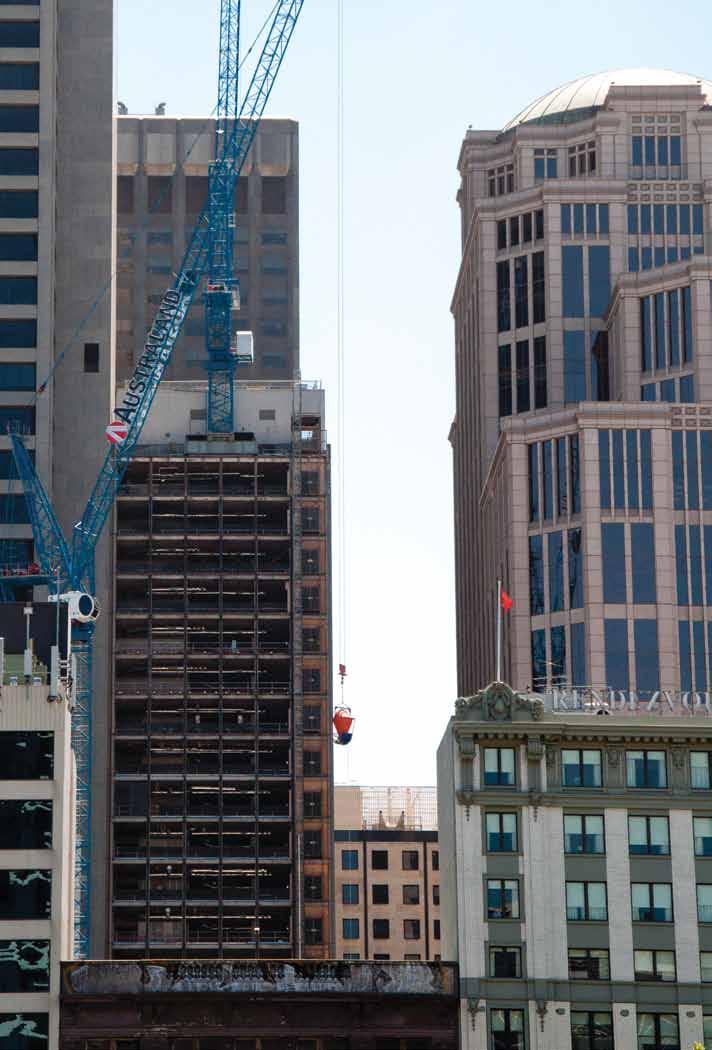
GREEN ISSUE: PROPERTY VICTORIA APRIL/MAY 2013 20 perfect time for Building Retrofits
per fect tim e for Building Retrofits

Thecurrent commercial building market needs a greater focus on the refurbishment of existing buildings. Green is the norm for new builds but the retrofitting of existing B and C grade buildings is the elephant in the room. The return on investment is now an undisputable fact but it is not happening at a pace that reflects urgent attention.
The business case for retrofitting is clearly established; for landlords, efficiency gains translate into operational improvements, reduces long term capital investment and stablises long term tenancies and profitability. For tenants, energy savings are immediate but it is also about the improved indoor comfort and productivity gains that reap optimum results over a longer term. Then there is of course the cachet that comes with being serious about corporate social responsibility.
According to data from the Green Building Council of Australia, new commercial buildings, which are now impacted by green credentials, account for only approximately five per cent of total building stock. There is an enormous opportunity for the retrofitting of the building stock that is approaching the end of its life cycle, particularly where we have 80 per cent that is greater than 10 years old.
There remains however a general trepidation among landlords to embrace retrofitting as a worthwhile investment because of the five-to-10 year payback period. But financing tools such as Environmental Upgrade Agreements (EUA) and their inherent capability to roll back payback periods, are now eroding this argument.
EUA are a finance innovation which offer the potential to unlock the retrofitting of Australia’s B and C grade buildings. EUA effectively use the energy savings to pay for the retrofit ensuring the tenant will never be worse off, while making the repayments via a charge on the council rates. The clever part of the concept is that the loan is paid from energy savings. It is a no-brainer
for landlords as reflected in the scheme’s traction in Sydney and Melbourne. Unlike the industry’s supply-side push for new green buildings when the concept was in its infancy, energy efficient buildings are demand driven.
For many tenants, NABERS and Green Star ratings are nonnegotiables. Landlords are finding themselves in a cycle of longer vacancies, declining rents and lumbered with ageing and poorly performing infrastructure.
Mandatory disclosure for commercial buildings means there is nowhere for poor performers to hide. This encourages property owners to employ sustainable measures.
Improvements in technology, and the corresponding decline in costs of such technology, only enhance the argument for building retrofits. Energy efficient HVAC systems, water saving hydraulic fitouts and advancements in lighting technology, have combined to deliver significant reductions in a building’s footprint.
Norman Disney & Young’s (NDY) work on Casselden Place and 600 Bourke Street in Melbourne’s CBD are just two recent examples of the improved efficiencies and cost minimisation through performance optimisation.

With both projects, NDY facilitated a package of environmental upgrade works which have improved energy efficient outcomes resulting in whole-of-life cost savings. Casselden Place is now a 4.5 Star NABERS rated building while energy usage at 600 Bourke Street has dropped by approximately 20 per cent and 35 per cent for natural gas.
It is true that the built environment remains the most significant sector for greenhouse gas abatement in Australia. Now is the perfect time to repair Australia’s ageing building stock. Spiralling energy costs, technology advancements, client demand, financial incentives, commercial disclosure and government policies are converging to ensure the re-lifting of buildings is an industry priority. This is most certainly a case of watch this space.
GREEN ISSUE: PROPERTY VICTORIA APRIL/MAY 2013 21
Tony Arnel is the Global Director of Sustainability at Norman Disney & young.
Tony Arnel
perfect time for Building Retrofits
Norman Disney & Young
SUSTAINABLE DEVELOPMENT CONFERENCE
FRIDAY 24 MAY 2013
This is the must attend conference for Australia’s property industry and sustainability pioneers.
The sixth annual Victorian Sustainable Development Conference is coming and it is looking at your bottom line!
As the evidence mounts, sustainable development is now not only important for the environment, but it is vital for promoting healthy workplaces and c ommunities; a key component for any successful portfolio and ensuring your investments will stand the test of time and the changing climate.
Don’t miss this exceptional line of up of practical, technical and inspirational speakers!
KEY SPEAKERS
Donald Bates, Director, Lab Architecture Studio and Chair of Architectural Design, University of Melbourne
Juliet Jiang, Senior Vice President, BROAD Sustainable Buildings Group, China
Karl Sullivan, General Manager Risk and Disaster, Insurance Council of Australia
Joe Van Belleghem, Global Head of Sustainability, Lend Lease
Tony Arnel, Global Head of Sustainability, Norman Disney & Young
Damien Crough, Business Development Manager, Unitised Building
KEYNOTE LUNCH

Friday 24 May - Peninsula, Atlantic - Central Pier, Docklands
Todd Sampson, CEO, Leo Burnett
HEAR about the next wave of innovation and sustainable development trends
UNDERSTAND what climate change means for your bottom line and the importance of resilience
EXPLORE the true value of a ‘green’ rating and the key drivers for sustainable practices
UNCOVER real examples of shared precinct infrastructure and how it benefits development


ENGAGE with international and local pioneers - Is prefabrication the answer?

For more details visit: www.propertyoz.com.au/vic or call: 03 9650 8300 REGISTER NOW www.propertyoz.com.au/vic Major Partners Lunch Partner Technology Partner Handbook Partner Supporting Partner JOIN THE CONVERSATION IN 2013.....
REGISTER ONLINE
New Division Council
Property Council of Australia, Victorian Division Council 2013-14
Division President
Andrew Whitson
General Manager - Residential Development Stockland
Vice President
l orenz Grollo Director Grollo Australia
Vice President
Adrian Pozzo
Chief Executive Officer Cbus Property Ltd
Treasurer
David Hodgson
Managing Director Hodgson Partnership

Immediate Past President
Philip Soumilas Director Buildcom Australia Pty Ltd

Mark Pratt General Manager, Property, Mortgages and Capital Markets Australian Unity Investments






Brendan Rogers Director Urbis
Roz Hansen Director Roz Hansen Consulting Pty Ltd

Darren Whitelegg
Managing Director, Real Estate Management Colliers International
GREEN ISSUE: PROPERTY VICTORIA APRIL/MAY 2013 24 New Division Council






GREEN ISSUE: PROPERTY VICTORIA APRIL/MAY 2013 25 New Division Council
Daryl Browning Chief Executive Officer ISPT Pty Ltd
Roger Teale Business Development Manager Lend Lease
Fiona Tellefson General Manager, Project Management APP Corporation Pty Ltd
Robert Pradolin General Manager, Residential Australand Holdings Ltd
Carolyn Viney Deputy CEO Grocon Pty Ltd
LEADERSHIP COMMUNICATION WOMEN in PROPERTY for A 1½ day practical workshop helping Property Council of Australia member companies & women gain business advantage. Presented by: Property Council of Australia - VIC OMEN Promoting excellence PROPERTY Endorsed by: Women & Diversity in Property Committee (NSW) 8 & 17 July 2013 11 & 21 November 2013 Visit www.propertyoz.com.au/vic for all the details on how to register
Bryce Moore Director Moremac Property Group Pty Ltd
Update: Mentor programme 2013
Innovation in the boardroom
The World Economic Forum (WEF) publishes a Global Competitiveness Report every year in which Australia does reasonably well in all 12 categories, except for innovation. We know from Australia’s own Committee For Economic Development (CEDA) that at the start of the 21st century, world economic production is yet again transforming; cross-firm collaboration, world scale production efficiency, integration into global supply chains and skilled knowledge workers are all becoming increasingly important.
A common theme is expanding connectedness between different firms, between different locations, and between people. However, recent economic theory and data suggests that “the tyranny of distance” has not abated and will continue into the future.
From the perspective of Australians taking a leadership role in emerging economic environments, what do we need to do to improve business innovation?
Almost a third of the world’s CEO’s say their biggest opportunities for growth lie in developing new products and services to differentiate themselves and remain competitive. They are looking to grow outside their core competency and market sector by extending their operational footprint, by building strategic alliances and by creating more explicit supply/support networks that include research and development and knowledge management.
The 12 points, 12 pillars allow boards to examine a full range of internal and external factors that, once imbedded, result in a company wide culture of innovation which in turn delivers:
• Multi channel strategic objectives that have specific commercially viable outcomes;
• Internal and external customers the ability to integrate into the future state;
• Seamless management of the portfolio of existing investments and businesses; and
• Fast, accurate and authentic data collection, storage, manipulation and retrieval.
Other key aspects of effective collaboration, resulting in a culture of innovation, include knowledge management and the major cultural and behavioural problems typically encountered when adopting a knowledge-management initiative.
More often than not conflict is created when there is a dichotomy of thinking between the various levels of hierarchy. When the strategic intent does not align with the behavioural norms of a company, productivity suffers. The current concept of ‘do more with less’ people becomes an impossibility and the emotional intelligence of knowledge workers continues to abate. Mentoring and succession planning are critical initiatives that are often relegated to the back burner in times of economic hardship. CEO’s are focused on trying to manage more efficient space utilisation, decrease churn, minimise costs and promote the brand, all of which requires the active participation and engagement of their people.
People who do not necessarily like to share their best ideas, do not like to use other people’s ideas for fear that they will be perceived as less knowledgeable and who prefer not to collaborate because they tend to consider themselves to be the experts.
So how do you engage and move from an environment of command and control to one of collaboration and trust?
The 12-points diagnostic is a high level decision making tool that highlights the key areas of a companies innovation readiness. It outlines the methodology and skills required to assist in the process of creating change and improvement, in people and process.
One example of innovation readiness can be found in a company’s ability to embrace perspectives on Enterprise Social Networking. Social networking has been shown to create a culture in which profile, status and expertise are tied to skills in knowledge sharing and distribution.
If behaviour truly is tacit approval to behave in the same manner, then the boardroom must become the incubator of innovation and the company and its people the implementer.
Thanks again to our Programme partners.
GREEN ISSUE: PROPERTY VICTORIA APRIL/MAY 2013 26
Mentor programme 2013 Card_01.pdf 1 18/07/11 11:29 AM
Kristina Reynolds Collaboration Hub
property po dium
Living and working sustainably
Jeffrey
Robinson, Aurecon’s Sustainable Buildings Leader, embodies sustainability in all aspects of his life. Aurecon’s brand new office, where he spends most of his time Monday to Friday has a bright and buoyant atmosphere; pot plants hang from the walls, natural light shines through surrounding glass panels and fresh air filters through open windows.
Although Melbourne’s weather is not on its best behaviour today (outside it is raining sporadically and the wind is strong, gusty and chilly), the building benefits from a refreshing and natural breeze. It is far more pleasant than the stifling air produced by conventional air conditioners.
The five work levels are interconnected by central stairs and the two coffee machines alternate between them every few months. This is done purely to encourage staff to walk around and interact with those based on different floors.
These feats are more than a lucky coincidence, they are the result of strategic planning and smart building design.
Living out a personal and professional commitment to sustainable living
Mr Robinson offers 10 low cost tips to help ease your environmental footprint, both in and out of the workplace.

1. Choose a more sustainable energy source
Choose an energy provider that employs sustainable practises.
2. Buy your food locally
There is a large transport component to the food you buy, so try to source it locally, like from the closest farmer’s market.
3. Be an informed consumer
Ask companies what they are doing to help the environment. Support those who are doing the right thing from
Mr Robinson says Aurecon’s engineers, in partnership with Lend Lease, endeavoured to build an office space that would benefit the well-being of the staff just as much as it would the environment. “If we’re not putting people at the centre of the properties we’re designing, we’re designing redundant buildings.”
The best way to encourage teamwork, collaboration and productivity is to ensure the occupants within the building enjoy being there says Mr Robinson. Fortunately, the interests of the staff and the environment align and Aurecon has employed sustainable practises to serve both.
Aurecon is not the only company to recognise the importance of such technology. A large proportion of the building sector has responded quite well to issues of global warming; “the biggest challenge is this thing about housing liveability.”
“There is more information on the European appliances and the granite bench tops than the levels of insulation. How well is the building orientated? What is the quality and energy efficiency of the services?”
a sustainability point of view and give them your business. By asking these sorts of questions, you will also encourage a ripple effect.
4. DIy double glazed windows
You can buy plastic sheets from most hardware stores which can be attached to your windows using a hairdryer. Once attached, they function as double glazed windows to keep temperature extremities out of the room.
5. Draw the blinds
Simply drawing the blinds is another good way to stop the outside weather from coming inside.
6. use ceiling fans
Ceiling fans are cheap to install, run at a low-cost and are very effective at cooling in the summertime.
The public need to be better educated when it comes to buying property says a passionate Mr Robinson. “If we can get people making better choices around the houses that they get, we’re setting them up for a much more comfortable and affordable existence.”
Mr Robinson worked with the construction team on his standard project home in Highett to include environmental upgrades. He says it was a great, economical way to ensure he was investing in a smart home.
Now, over a decade later, he still lives there with his wife and three daughters (13, 15 and 18 years old). Between them they have one car, his wife’s, and they manage just fine. “It’s not about dollars it’s about trying to walk the talk.”
And walk the talk he does. They have a garden where they are growing their own food, his primary method of transport is public and if his daughters ask him to buy them a car, he will say no.
Waving goodbye from the Aurecon foyer on this drizzly day, a cheerful Mr Robinson radiates sustainable lifestyle choices.
7. use a door draft stopper
These snake-like bean bags block drafts leaking in through the gap under the door.
8. Turn off the lights
Get in the habit of switching off when you leave a room.
9. Use public transport or a bike
If you are near public transport or can cycle and it is reasonable to do so, avoid taking the car.
10. Car share
Organise to car pool with friends and colleagues, or consider online car sharing schemes.
GREEN ISSUE: PROPERTY VICTORIA APRIL/MAY 2013 27 property podium
Jeffery Robinson Aurecon
Article written by Hyatt Nidam, Property Council of Australia
Spotlight on ta smania
The new Tasmanian Division Council:
Immediate Past President
Matthew Page, Knight Frank President
Tim Johnstone, Edwards Windsor Vice President
Sam Hogg, Porky and Co Vice President
Daniel Hanna , The Federal Group Treasurer
Glenda Sorrell, Matrix Management

Gerard O’Brien, Silverleaf Investments
New Division Council
One of Tasmania’s leading businessmen, Errol Stewart of the Jackson Motor Company, has put his weight behind the Property Council of Australia’s Tasmania Division.

Mr Stewart, along with Gerard O’Brien of Silverleaf Investments (currently developing the Cat and Fiddle arcade), Barney Phillips of the CITTA Group (developers of Parliament Square) and Tim Rutherford of MyState, are now members of the Property Council’s Tasmanian Division Council.
The four new members join Robert Rockefeller of Nekon, Daniel Hanna from the Federal Group, Greg Cooper from Health and Human Services, Tim Johnstone from Edwards Windsor, Andrew Sypkes of the Sypkes Group, Matthew Page from Knight Frank, Sam Hogg from Porky and Co as well as Arnold Sierink of Colonial First State.
In addition, property industry professionals are represented by Glenda Sorrell from Matrix Management, Ian Armitage of SEMF, Frazer Read of GHD and Keith Drew of Xsquared Architects. The new Division Council had been elected for the next two-year term, with all sectors of the property industry represented through its membership. The Division is expected to have unheralded strength and significant lobbying capacity.
Errol Stewart, JMC
Barney Phillips, CITTA
Tim Rutherford, MyState
Robert Rockefeller, Nekon
Andrew Sypkes, Sypkes Group
Greg Cooper, Department of Health and Human Services
Arnold Sierink, Colonial First State
Ian Armitage, SEMF
Frazer Read, GHD
Keith Drew, Xsquared Architects
Planning reform could undermine future development
The property industry is very concerned that the planning reform which incorporates the Interim Planning Scheme process has the potential to seriously and detrimentally affect future development.
Proposals under Section 43A of the Land Use Planning and Approvals Act (LUPAA) by their nature often involve larger master plans and developments which require modifications to planning schemes; both minor and significant. They often involve large scale investment and the opportunity for economic development within a council area.
The industry’s immediate concern is the need to minimise disruption. This includes minimising the reworking of plans, reporting and approval time frames for undetermined 43A applications during the introduction of Interim Planning schemes, and the transition to final planning schemes.
As LUPAA stands, the 43A process cannot be applied to an Interim Planning Scheme. 43A applications that are undetermined are terminated on the introduction of the scheme and the process does not provide a coordinated facility for planning amendments and development applications to be considered concurrently.
The uncertainty around the content and timing of interim planning schemes, the hearing processes, and final planning schemes (all of which is likely to be much longer than originally anticipated) will be a significant deterrent to investment and needs to be addressed immediately.
There is a facility under the dispensation process for a local provision of an Interim Scheme to be dispensed with; however there is no ability to consider a permit application concurrently. Furthermore, there is no defined time frame for determination of the dispensation.
GREEN ISSUE: PROPERTY VICTORIA APRIL/MAY 2013 28
Spotlight on tasmania
Major partner
Mary Massina Executive Director, Tasmania Division
Office Market Report Breakfast
Speakers:
Tony l a ndrigan, Colliers International
Roger Scrivener, Urbis
Scott Travers, DEXUS
Peter James, ISPT
Proudly partnered by:
Property Outlook


Speakers:
Craig James, CommSec



Peter McGuinness, IPD Australia

Cameron Kusher, RP Data
Richard Jenkins, Knight Frank
Proudly partnered by:
GREEN ISSUE: PROPERTY VICTORIA APRIL/MAY 2013 29 Events offICE MARkEt REpoRt BREAkfASt 7 fEBRUARy 2013
pRopERt y oU tLo ok 13 fEBRUARy 2013
Residential Outlook
Speakers:
Michael Barlow, Urbis
Ash Williams, Evolve Development
Christian Graeme, Mirvac
Rob Adams, City of Melbourne



Robert Papaleo, Charter Keck Cramer
Mark Woodland , Echelon Planning

Jason Shaw, Stockland

Malcom Snow, Places Victoria
Proudly partnered by:
Retail Outlook
Speakers:
Simon Rumbold , Urbis
Grant l evy, Langer and Rogers
Brian Walker, Retail Doctor Group
Katharina Kuehn, RDG Insights
Graham Jackson, Hybris
Rob McGauran, MGS Architects
Gilbert Rochecouste, VillageWell

30 Events GREEN ISSUE: PROPERTY VICTORIA APRIL/MAY 2013 RESIDENtIAL oU tLo ok 14 fEBRUARy 2013
REtAIL oU tLo ok 14 fEBRUARy 2013
Industrial Outlook
Speakers:
Mark Courtney, Colliers International
Shane Robb, Urbis
Stephen Bradford , Port of Melbourne Corporation

linc Horton, Melbourne Airport
Proudly partnered by:
Sustainability Outlook
Speakers:
Stuart White, University of Technology Sydney


Tim O’l oan, AECOM
Justin Ray, Stockland
Andrew Nieland , Lend Lease



Michael Cook, Investa
Kent Shubert, Department of Primary Industries
Ros Magee, Spowers
Proudly partnered by:
31 Events GREEN ISSUE: PROPERTY VICTORIA APRIL/MAY 2013 INDUStRIAL oU tLo ok 14 fEBRUARy 2013
SUStAINABILIty oU tLo ok 14 fEBRUARy 2013
Retirement Outlook
Speakers:
Peter Brown, FKP Property Group








Barry Mann, Stockland
Philip David , Urban Neighbourhoods
Jason Anderson, MacroPlan Dimasi
Chris Smith, Australian Unity
Chiou-See Anderson, Elements Third Age Living
l oc Nguyen, Bendigo Bank
Rosemary Southgate, Russell Kennedy
Proudly partnered by:
32 Events GREEN ISSUE: PROPERTY VICTORIA APRIL/MAY 2013 REtIREMENt oU tLo ok 26 fEBRUARy 2013







33 Events GREEN ISSUE: PROPERTY VICTORIA APRIL/MAY 2013
RESIDENtIAL BRIEfING 20 fEBRUARy 2013
Standardising Development Contributions
Speakers:
Kathy Mitchell and Chris De Silva , Standard Development

Contributions Ministerial Advisory Committee
Panel:

Matt Ainsaar, Urban Enterprises
Brad Paddon, APD Developments


David Turnbull, City of Whittlesea
RESIDENtIAL BRIEfING 20 MARCH 2013
Places Victoria Spotlight
Speakers:
Peter Seamer, Places Victoria


Brendan Rogers, Urbis
Proudly partnered by:

34 Events GREEN ISSUE: PROPERTY VICTORIA APRIL/MAY 2013
Outlook 2013
Speakers:
Bob Schwartz , Pitney Bowes
Peter l awlor, Bankwest


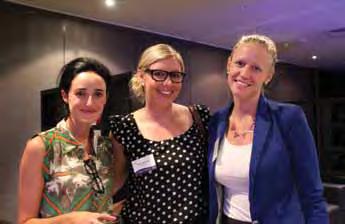
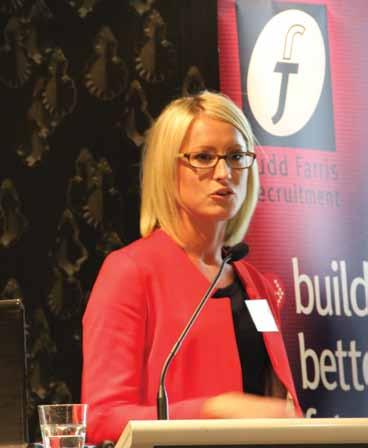



Matt Belford , ID_Land
Proudly partnered by:

35 Events GREEN ISSUE: PROPERTY VICTORIA APRIL/MAY 2013 fU tURE DIRECtIoNS oU tLo ok 21 fEBRUARy 2013
Business Lunch
Speaker:
The Hon. Bill Shorten, Minister for Employment and Workplace Relations, Financial Services and Superannuation

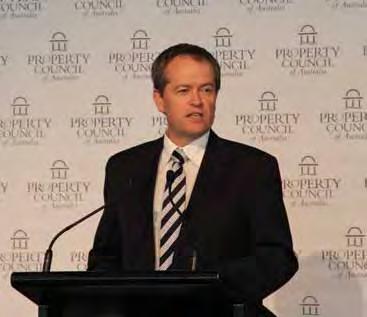

As consulting engineers, we know that there are no ‘pre-packaged’ sustainability solutions for our client’s projects. Each project needs to be specifically tailored for highest efficiency and excellent results. At NDY, sustainability is not an ‘off the shelf’ approach –it is an intrinsic part of everything we do.

36 Events GREEN ISSUE: PROPERTY VICTORIA APRIL/MAY 2013 VICtoRIAN DIVISIoN BUSINESS LUNCH 22 fEBRUARy 2013
www.ndy.com Scan QR code to learn more about sustainability at NDY or visit:
If only it was this simple.
Chatting with Champions




Moderator:
Hamish Mcl achlan

Speakers:
Cameron ling

Simon O’Donnell
Proudly partnered by:
37 Events GREEN ISSUE: PROPERTY VICTORIA APRIL/MAY 2013 VICtoRIAN DIVISIoN BUSINESS LUNCH 21 MARCH 2013
Championship Golf Day







38 Events GREEN ISSUE: PROPERTY VICTORIA APRIL/MAY 2013 GoLf DAy 1 MARCH 2013
Proudly partnered by:









39 Events GREEN ISSUE: PROPERTY VICTORIA APRIL/MAY 2013
Lawn Bowls Competition
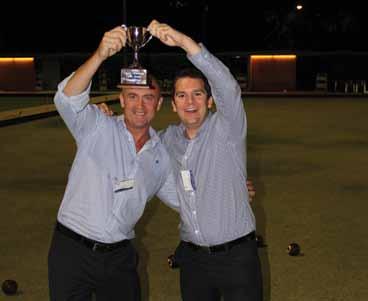






Proudly partnered by:

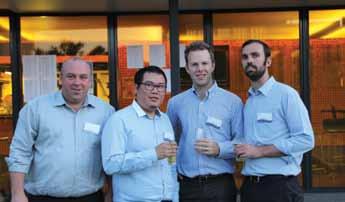
40 Events GREEN ISSUE: PROPERTY VICTORIA APRIL/MAY 2013
fU tURE DIRECtIoNS 26 MARCH 2013
The Leaders Debate
Speakers:
The Hon. l a ra Giddings, Premier of Tasmania

Will Hodgman, Leader of the Opposition
Proudly partnered by:
Office Market Report
Presenter:
Richard Steedman, Opteon Tasmania
Speakers:
Errol Stewart, JMC
Tim lucas, Sultan Holdings



John Gilbert, MyState
Proudly partnered by:

41 Events GREEN ISSUE: PROPERTY VICTORIA APRIL/MAY 2013 tASMANIAN BUSINESS LUNCH 20 MARCH 2013
tASMANIAN DIVISIoN INDUStRy BRIEfING 7 fEBRUARy 2013
Visit www.propertyoz.com.au for all the latest on our events.
Events Calendar
May and June 2013
Victoria
Thursday 2 May
Thursday 9 May
Directions
Division Breakfast With David Shafer, Executive Director, Kogan.com.au
ZINC @ Federation Square
for 7.30am - 9.00am
Friday 10 May Planning Industry Forum Open Space Strategy Update RACV City Club Level 2, 501 Bourke Street 8.30am for 9.00am - 12.00pm
Tuesday & Wednesday 14-15 May l easing Fundamentals
Tuesday 21 May
Friday 24 May
2 day professional development course
Property Council of Australia Level 7, 136 Exhibition Street
9.00am - 4.00pm
Moderated by Tim Colebatch, The Age Arup
Economic Development Report – Briefing
Sustainable Development Conference
With Ms. Juliet Jiang, Senior VP, Broad Group China and Keynote lunch with Todd Sampson, CEO, Leo Burnett
Level5, 215 Spring Street
4.00pm for 4.30pm - 6.00pm
Peninsula @ Atlantic Docklands
8.30am - 5.00pm
Thursday 30 May Future Directions Citiclub
113 Queen Street 6.00pm - 8.30pm
Tuesday 4 June Retail l eases Act Course
Thursday 6 June
Business lunch
With The Hon. Robert Clark, MP Industrial Relations, Attorney-General Minister for Finance
Friday 14 June
Tuesday 18 June
Thursday 20 June
Tuesday 25 June
Infrastructure Forum
Half day event
Social Media Forum
How to use social media for business
EA/PA in Property Course
One day professional development
End of Financial year Cocktails
Invitation only event for Division Council, Committee Members, New Members and Division Sponsors
Minter Ellison l awyers
Rialto Towers, 525 Collins Street
8.30am - 4.00pm
RACV City Club
Level 17, 501 Bourke Street
12noon for 12.30pm - 2.00pm
RACV City Club
Level 2, 501 Bourke Street
9.00am - 12.00pm
TBC
9.00am - 5.00pm
Property Council of Australia
Level 7, 136 Exhibition Street
9.00am - 4.00pm
Aurecon Head Office
Level 8, 850 Collins Street, Docklands
6.00pm - 8.00pm
GREEN ISSUE: PROPERTY VICTORIA APRIL/MAY 2013 42
DAy DATE EVENT VEN u E & TIME
Future
Citiclub
6.00pm
113 Queen Street
- 8.30pm
Retail
7.15am
Events Calendar




GREEN ISSUE: PROPERTY VICTORIA APRIL/MAY 2013 43 Printed on ecoStar 100% recycled paper. ecoStar is an environmentally responsible paper, made carbon neutral and manufactured from 100% post consumer recycled paper in a process chlorine free environment under the ISO 14001 environmental management system. Events Calendar DAy DATE EVENT VEN u E & TIME Wednesday 26 June Special Rugby lunch Wallabies vs British & Irish lions With Stirling Mortlock, Rory Underwood and Adam Frier ZINC @ Federation Square 12.30pm for 1pm - 2.30pm Thursday 27 June Future Directions Citiclub 113 Queen Street 6.00pm - 8.30pm Visit www.propertyoz.com.au for all the latest on our events. Discover The Vital Secrets Of How To Promote You And Your Business Using LinkedIn, Facebook And Twitter. Are you confused about how to use social media strategically? Do you have a personal social media plan that generates leads for your business and new opportunities for you? Would you like to know how to use social media to position yourself as a credible, trusted expert in your eld? • • • Social Media or Bus ess How o Use Tuesday 18 June 2013 9.00am registration for 9.30am - 4.30pm Venue TBC Member $250 Non-Member $375 REGISTER ONLINE
THE GUILD
The project successfully combined intelligent planning and use of materials to create environmentally responsive affordable housing that focuses on liveability.
The Guild is the result of an ongoing pursuit to provide high quality affordable housing models for both developers and residents alike. It sets a new benchmark for inner urban residential developments environmentally, socially and economically.


The speed of sales and subsequent settlements are testimony to all involved.

For further information visit us at www.pta.com.au
 Peddle Thorp Architects worked closely with our development client the LAS group, the state government, MCC and builder L.U. Simon to produce the Guild apartments at 152 Sturt St Southbank.
Peddle Thorp Architects worked closely with our development client the LAS group, the state government, MCC and builder L.U. Simon to produce the Guild apartments at 152 Sturt St Southbank.
















































































































































































 Peddle Thorp Architects worked closely with our development client the LAS group, the state government, MCC and builder L.U. Simon to produce the Guild apartments at 152 Sturt St Southbank.
Peddle Thorp Architects worked closely with our development client the LAS group, the state government, MCC and builder L.U. Simon to produce the Guild apartments at 152 Sturt St Southbank.